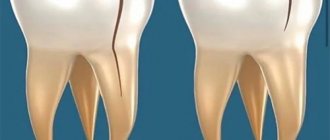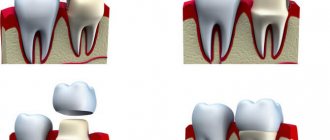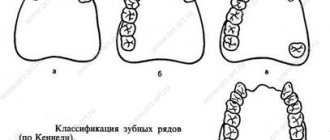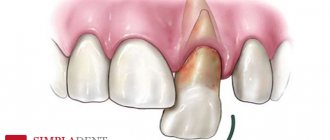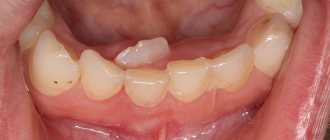The loss of a front tooth is very acute. And this is not surprising. Even if there is a slight darkening of the enamel on the front incisors, the person already begins to feel uncomfortable - he is embarrassed to talk and smile. And the absence of even one tooth along the smile line only aggravates psychological discomfort. Therefore, such problems need to be solved as quickly as possible.
Prosthetics for anterior teeth
are primarily aimed at high aesthetics. Therefore, they use materials that effectively combine strength and high aesthetic characteristics. The Ilatan Clinic in Moscow uses various methods for restoring front teeth using advanced technologies and the latest generation materials. Treatment methods and cost depend on the clinical picture.
Problems arising from missing teeth
The absence of even one dental unit in a row leads to serious consequences:
- Due to the lack of lateral support, neighboring teeth begin to shift;
- if a tooth is lost along with the root, the bone tissue in this area begins to quickly atrophy and decrease;
- chewing function is impaired, which leads to problems with the gastrointestinal tract;
- the bite changes, which leads to deformation of the position of the jaw joint and dysfunction of the umbilical nervous system;
- The shape of the face changes, the upper lip begins to recede, and wrinkles appear.
The longer a tooth is missing, the more severe the consequences will be. If a tooth is lost in the smile area, patients are offered different options for restoring the dentition. The method depends on the clinical picture.
What does prolonged absence of teeth lead to?
If you have lost a tooth, we recommend that you do not delay replacing it for a long time. In addition to an aesthetic defect, long-term absence of a tooth can lead to a number of negative consequences, which not everyone knows about. We will talk about the main problems that can be encountered if the integrity of the dentition is not restored.
Change in appearance
The dentition is a single, well-coordinated mechanism that functions fully only if it is intact. The load when biting and chewing food is distributed evenly both on the teeth and on the periodontal tissue (which surrounds and holds the tooth).
In addition to the chewing function, the preservation of the dentition affects a person’s diction and appearance. If front teeth are missing, lip recession may develop, the loss of canine teeth can change the smile, and the removal of chewing teeth can change the line of the cheeks. Soft tissues remain without support, the proportions of the face change, the corners of the mouth sag down and nasolabial folds appear. The motility of small facial muscles changes, exacerbating existing wrinkles and contributing to the appearance of new wrinkles.
Increased load on other teeth
Each group of teeth performs its own function, and when the chewing teeth are lost, the front teeth take over their function, but their anatomical structure does not correspond to the load placed on them. This leads to abrasion of the edges of the tooth, the appearance of cracks and darkening on the enamel. The height of the bone tissue that holds the tooth decreases, and over time, teeth that are under excessive load acquire pathological mobility, in other words, they begin to loosen.
Tooth displacement and the occurrence of functional disorders
After a tooth is removed, its antagonist (the tooth of the opposite jaw, with which it comes into contact during chewing) loses support and moves. The same thing happens with neighboring teeth on both sides of the removed one. This leads to the formation of malocclusion, uneven dentition and disorders in the jaw joints, which can lead to arthrosis. Patients develop functional gastrointestinal disorders: gastritis, pancreatitis, cholecystitis.
Bone loss
3–5 months after tooth extraction, the bone tissue that previously supported the tooth and could become a support for the implant begins to decrease, which is due to the lack of the previous chewing load. For example, a similar situation occurs with muscles after applying plaster. The longer a patient waits to see a dentist after tooth extraction, the more pronounced the bone deficiency becomes, and the more difficult the implantation procedure will be in the future.
Fortunately, modern technologies make it possible to restore the dentition even with complete loss of teeth and bone tissue atrophy, but the sooner the patient consults a doctor, the easier and cheaper it will be.
The possibilities of modern dental restoration techniques, fortunately, are practically unlimited: implant-supported crowns, orthopedic bridges and removable dentures. MedGarant specialists will always be able to offer the best option for you. Make an appointment and your doctor will create an individual treatment plan for you.
Make an appointment with a doctor by calling:
- Clinic on the street. Smolenskaya, 9
+7 Make an appointment
- Clinic on the street. Badaeva, 6, building 1
+7 Make an appointment
- Clinic on Menedeleev Blvd., 9, building 1
+7 Make an appointment
Aesthetic restoration of anterior teeth
If you need to correct the appearance and shape of incisors or fangs, the best solution is ultra-thin veneers or lumineers. Plates 0.2 - 0.3 mm thick made of ceramic or zirconium are fixed to the outside of the teeth, eliminating all visual defects, making the smile luxurious. Such microprostheses do not require significant intervention in the structure of the teeth. The enamel is prepared exactly to the thickness of the plate, and the veneers are fixed to the surface of the teeth using a special glue (bond). Typically, veneers are installed on 6-10 upper and 4-6 lower teeth along the smile line.
How does a doctor restore a tooth?
If the tooth is intact, the doctor will suggest replantation. To begin with, radiography is performed, followed by the following procedures:
- Thorough antiseptic treatment of the oral cavity as a whole.
- Installing the unit in its original place. Localization is not carried out visually, but with the help of repeated x-rays.
- The edges of the hole are sutured.
- To secure the unit in position, a dental splint is required.
- The victim is sent home and antibiotics, anti-inflammatory drugs or painkillers may be prescribed.
- After a couple of days, you need to visit the dentist again. The healing of the tooth is assessed.
- If necessary, the doctor adjusts the splint.
- Complete engraftment will not occur quickly; it usually takes from 3 to 6 months. During the specified time, the unit remains mobile, so you should be especially careful and follow all medical recommendations.
- After final healing, the splint is removed.
If the front tooth is destroyed, but the root is preserved
In case of significant destruction of the coronal part (up to 50%), the front tooth can be restored using prosthetic crown. The affected tooth is depulped, followed by filling the canals, given the desired shape (prepared), if necessary, the root is strengthened with a stump insert. The crown is fixed onto the prepared stump using dental cement.
For the smile area, it is better to choose all-ceramic or metal-free crowns made of zirconium or aluminum oxide. These materials have a shade and degree of transparency similar to natural enamel. The doctor will select an option so that the restored tooth does not stand out in any way in the general row.
FAQ
Dental restoration is a very broad area in dentistry, with a special approach to each case. Therefore, patients often have various questions, the most common of which are:
- How much does it cost to insert a front tooth? Depending on the method, materials, additional treatment and many other features, the cost can vary greatly. You need to come to the clinic, where a specialist will answer any of your questions: how much does it cost to insert a pin and build up a tooth; At what age can teeth be inserted? how much does it cost to insert a chewing tooth?
- Is it possible to insert a tooth if there is no root? It is possible, the dentist may recommend implantation, a bridge, or a removable denture.
- What types of implantation exist? Today, single-stage, one- and two-stage implantation is used.
- The tooth was removed. How long after can teeth be inserted? It all depends on the individual characteristics of the patient. The defect can be fixed in one day, but sometimes you will need to wait several months.
- How much does it cost to get a dental implant? The cost of dental implantation is from 25,000 rubles.
- Where is the best place to insert teeth? Preference should be given to certified clinics that employ experienced dentists and have all the necessary equipment for diagnosis and treatment, as well as high-quality materials.
- Does it hurt to insert a pin into a tooth? Modern painkillers can completely eliminate pain and discomfort.
- How to insert teeth without grinding down the adjacent ones? You can insert one tooth without grinding the adjacent teeth using a removable denture, implant or pin.
- How much does it cost to insert a metal-ceramic tooth? The cost of one unit of metal-ceramic crown starts from 8,000 rubles.
If you have additional questions, you can always ask them to an experienced dentist and get a competent answer.
How to choose an implant brand?
With complete absence of a tooth
Prosthetics for front teeth in the absence of them involves 2 main methods:
- Installation of a bridge prosthesis
- this method is suitable for replacing 1 to 4 missing incisors. A bridge is a structure of several connected crowns, 1-2 suspended in the center and 2 hollow on the sides, which are attached to adjacent supporting teeth. The main disadvantage of the method is the need to grind and often depulpate the supporting units, even if they are completely healthy. That is, if you need to restore 1 missing incisor, two adjacent ones will have to be injured. - Implant prosthetics
– technology allows you to restore any number of missing teeth in a row. An implant is implanted into the jawbone, which fully replaces the missing tooth root. After the implant has healed, an adapter (abutment) is installed on it, onto which an artificial crown is fixed, identical in shape and color to the natural tooth. If an entire segment of the dentition is missing (3 or more teeth), 2 artificial roots are implanted, onto which a bridge is fixed. - Prosthetics of the front tooth immediately after extraction
is performed using the express implantation method. Immediately after surgical removal of a tooth, an implant is screwed into its socket, an abutment and a temporary crown made of lightweight plastic are fixed onto it. The temporary crown is removed from the bite, does not take part in chewing, it is necessary only to preserve the aesthetics of the smile. After 2-3 months, when the implant has fused with the bone, the temporary prosthesis will be replaced with a permanent one made of durable, reliable material (metal-ceramics, zirconium, etc.).
Prosthetics on implants does not involve injury to neighboring units; implanted implants perform all the functions of a natural tooth root and prevent jawbone atrophy. Implants are implanted once and for all; only prosthetic structures are subject to replacement (if they break or end their service life).
Reason 4 – the longer teeth are missing, the more difficult it is to restore them
Patients who decide to have a tooth inserted after a long absence often face a certain problem.
Due to insufficient chewing load, the bone tissue atrophies over time and its volume becomes insufficient to install an implant. In such cases, it is necessary to use traumatic and expensive bone grafting techniques (sinus lifting, splitting of the alveolar ridge, etc.). The time spent on tooth restoration will also increase. When can teeth be inserted after extraction? It all depends on the specific case, the possible options for inserting teeth. Sometimes the defect can be restored in a very short time, but in some cases it will take longer - up to six months.
Don’t delay with dental prosthetics
Whatever the reason for delaying prosthetics, we urge you :
Don't miss the opportunity to live a healthy and fulfilling life!
Sign up for a consultation with an orthopedic dentist by phone or on the website >>
Share the link:
- Click here to share content on Facebook. (Opens in a new window)
- Click to share on WhatsApp (Opens in new window)
implantation, orthopedics, articles, surgery topics: bone atrophy, implantation, bone grafting, fixed prosthetics, covering prostheses, prosthetics, prosthetics on implants, removable prosthetics
Which prosthesis to choose if all teeth are missing?
In Russia, classical implantation is more in demand, since the immediate loading protocol is not used by all specialists due to the complexity of the procedure and subsequent prosthetics. To apply modern implantation concepts, it is necessary that the clinic meets all the requirements of the product manufacturer, and the doctor has undergone special training and internship. This requires large expenses from clinics and specialists, in addition, many patients cannot undergo the implantation procedure using the immediate loading technique due to clinical indications or due to limited budget. When choosing budget models, you cannot guarantee the result, since budget implants do not have such high reliability indicators as top manufacturers. Therefore, performing implantation in one stage when using cheap implants is a high risk for the patient. Experts do not recommend installing untested systems using the instant load protocol, since the result is unpredictable and if the operation is performed incompetently, the risk of jaw injury increases. Therefore, despite the delayed result, patients still choose the classic implantation technique for prosthetics in the absence of teeth.
When carrying out classical implantation, two stages are carried out. At the first stage, artificial roots are installed in the patient’s bone tissue, covered with a mucoperiosteal flap and sutures are applied. Without pressure or load, the implants take root in the bone ridge. When choosing budget implant models, the survival rate depends on the type of implant and the manufacturer. Modern clinics, as a rule, use high-quality products with a high degree of reliability. Engraftment occurs in 97-99% of cases when installed in two stages.
At the second stage, after complete engraftment, a gum former is installed inside the implants to create an aesthetic and natural gingival contour that will adhere to the prosthesis and cover the necks of the implants, protect against plaque formation, and prevent the development of peri-implantitis. If the fit is not precise, cavities are formed in which plaque quickly accumulates. It is difficult to remove, resulting in bad breath, inflammation of the gums, and the formation of tartar. To avoid such consequences, it is recommended to use an individual gum former, which will help create a beautiful contour and prevent the appearance of deposits between the denture and the gum.
After creating the gingival contour, the prosthesis is installed. To fix it, an abutment is used - an element connecting the implant and the prosthesis. Since the implant is completely immersed in the bone tissue, additional elements are used to fix the orthopedic structures. The abutment ensures correct load distribution over the entire surface of the implant and prosthesis. Its use prevents breakage and reduces the risk of loosening. If excessive pressure was nevertheless applied to the prosthesis, then if it breaks, only the removable part (abutment) will need to be replaced, while the implanted implant will remain undamaged.
When using a custom abutment, the bridge portion of the prosthesis can be fixed at the correct angle. Unlike standard types of abutment, when making an individual element, the angle of inclination of the prosthesis can be changed and made it most suitable for the patient. The angle of inclination determines how much load the prosthesis can withstand. For any deviations from the pressure axis, the implant and abutment will experience overload. If the lines of the abutment angle do not correspond to the natural position of the teeth and pressure on the fracture, the abutment may break when chewing hard food, even if the material is durable and made of high quality. Only if properly positioned can this element last for a long time. Standard abutment models are used if the location of the implants inside the bone allows them to be installed at a specific angle. In this case, the risk of breakdown is minimal. For this reason, implant manufacturers produce components for installing prostheses - abutments, formers, screws, plugs, etc. With a wide range of products, the doctor can select a standard product for prosthetics without risk to the patient.
The use of individual components such as an individual gum former, abutment and impression tray will allow, after installation of the prosthesis, not to experience discomfort when wearing the prosthesis, easy oral hygiene, and reduce the risk of complications.
Indications for classical dental implantation are complete or partial absence of teeth, the need to install a permanent prosthesis with permanent fixation in the oral cavity, an open palate and a natural volume of the prosthesis that corresponds to natural teeth and has an aesthetic appearance.
Contraindications to classical implantation are the presence of chronic diseases of the heart, lungs, blood, such as tuberculosis, hemophilia, oncology, type 1 diabetes mellitus, osteoporosis, disorders of bone tissue regeneration, weakened condition after a heart attack, stroke, long-term treatment. If the patient has chronic diseases that prevent surgical procedures, it is necessary to obtain additional consultation from the attending physician to eliminate the risk of complications. In the presence of atrophy, the installation of implants is contraindicated. In this case, it is recommended to undergo the procedure of osteoplasty - increasing the volume of bone tissue. After increasing the volume of the alveolar ridge, implantation can be performed. However, it is necessary to plan the procedure first of all in conjunction with the general plan for implantation and prosthetics.
What designs are best used to restore several teeth?
If two or three units are missing, it is optimal to replace them with the same number of crowns on implants. But in order to save money, you can also install a dental bridge. To fix it, it is also better to use titanium rods rather than abutment teeth. In this case, it is enough to install only two implants and make the middle crown cantilever. The most aesthetic and durable material for such prosthetics is zirconium. But for the restoration of chewing teeth, more affordable metal-ceramics are also quite suitable.
Where can you put your teeth?
Where to put the teeth? Implantation and prosthetics services in Moscow are offered by a large number of dental clinics. However, it is important to choose the right dentistry, where your treatment and dental restoration will be carried out at a high level of quality.
Always find out the reputation of the clinic before contacting it and remember that low prices for implantation and prosthetics are often not a reason for joy, but rather a reason to be wary and check all the information on dentistry even more carefully. High-quality dentures, crowns, implants cannot cost a penny!
If you want to have your teeth treated with prosthetics and implantation, we invite you to visit our modern dental clinic in Moscow - “VENSTOM”. We are ready to offer each of our patients: comfortable conditions for treatment, an individual approach, and high quality of all procedures performed.
With us you can have teeth placed using any of the technologies discussed in the article. Qualified specialists from our clinic will help you choose the optimal dental restoration technique for you! You can get an initial consultation on dental treatment at VENSTOM free of charge!


